
Faversham is a market town in Kent, England, 8 miles (13 km) from Sittingbourne, 48 miles (77 km) from London and 10 miles (16 km) from Canterbury, next to the Swale, a strip of sea separating mainland Kent from the Isle of Sheppey in the Thames Estuary. It is close to the A2, which follows an ancient British trackway which was used by the Romans and the Anglo-Saxons, and known as Watling Street. The name is of Old English origin, meaning "the metal-worker's village".

Reculver is a village and coastal resort about 3 miles (5 km) east of Herne Bay on the north coast of Kent in south-east England. It is in the ward of the same name, in the City of Canterbury district of Kent.
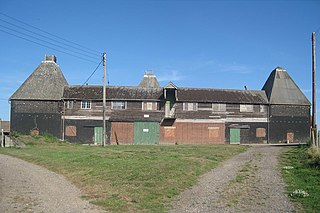
Luddenham is a widespread hamlet or small village north-west of Faversham in Kent, England, with many long-distance views across the Swale and the Isle of Sheppey. It is on the edge of Luddenham Marshes and is also home of Luddenham School. Oare Gunpowder Works are on the edge of the village. It had, according to Edward Hasted in 1798, 396 acres of low flat arable land and 200 acres of meadow and pasture, although half of those are marsh. It is in the civil parish of Norton, Buckland and Stone.
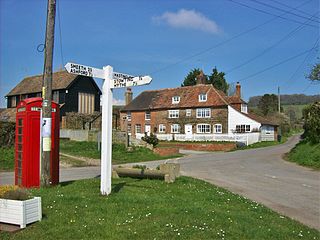
Brabourne is a village and civil parish in the Ashford district of Kent, England. The village centre is 4.5 miles (7.2 km) east of Ashford town centre.
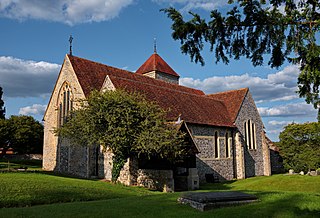
Godmersham is a village and civil parish in the Ashford District of Kent, England. The village straddles the Great Stour river where it cuts through the North Downs and its land is approximately one third woodland, all in the far east and west on the escarpment of the North Downs. It is six miles north-east of Ashford on the A28 road midway between Ashford and Canterbury in an Area of Outstanding Natural Beauty with the North Downs Way and Pilgrims' Way traversing the parish.

Teynham is a large village and civil parish in the borough of Swale in Kent, England. The parish lies between the towns of Sittingbourne and Faversham, immediately north of the A2 road, and includes the hamlet of Conyer on an inlet of the Swale, the channel that separates mainland Kent from the Isle of Sheppey. Other hamlets include Deerton Street, Frognal, and Teynham Street. Teynham also has a carnival court. There is selections every year when girls from 14-18 can audition to be Miss Teynham or a Teynham princess.

Preston or Preston-next-Wingham is a civil parish and village in the valley of the Little Stour in the Dover District of Kent, England. The village is on the B2076 secondary road. The parish includes the hamlet of Elmstone. The main river through the area is a tributary of the River Stour. The suffix 'next-Wingham' distinguishes the area from Preston-next-Faversham.

Ospringe is a village and area of Faversham in the English county of Kent. It is also the name of a civil parish, which since 1935 has not included the village of Ospringe.

Molash is a civil parish and village in Kent, South East England. It contains a small part of an Area of Outstanding Natural Beauty (AONB) - the North Downs - and is on the A252 road between Canterbury, Ashford and Faversham. Each of these is centred 7 miles (11 km) away.
Sellindge is a civil parish and village on the A20 road between Ashford and Folkestone in Kent, South East England. Sellindge is part of North Downs West Ward of Folkestone and Hythe District Council but part of the Elham ward of Kent County Council.

Herne is a village in South East England, divided by the Thanet Way from the seaside resort of Herne Bay. Administratively it is in the civil parish of Herne and Broomfield in Kent. Between Herne and Broomfield is the former hamlet of Hunters Forstal. Herne Common lies to the south on the A291 road.
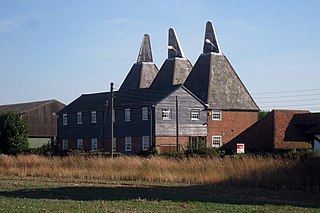
Sheldwich is a village and civil parish in the far south of the Borough of Swale in Kent, England.
Hernhill is a village and civil parish between Faversham and Canterbury in southeast England. The parish includes the hamlets of Crockham, Dargate, The Fostall, Lamberhurst, Oakwell, Staple Street, Thread, Waterham and Wey Street.

Leaveland is a hamlet and civil parish located in the Swale borough of Kent, South East England. In terms of topography, it is described as a "village surrounded by inhabited countryside", and is situated mostly on high ground. It is located 5 miles South of Faversham, West of Badlesmere, and on or close to the A251.The closest railway station to the area is Selling, which is just over three miles away, although Faversham station is more accessible and offers better services. The closest estuary is The Swale which separates the Isle of Sheppey from mainland Kent, and flows to the north of Faversham Creek.. Leaveland itself covers an area of 1.5 km2 and lies entirely within the Kent Downs Area of Outstanding Natural Beauty.

Ulcombe is a village near the town of Maidstone in Kent, England. The name is recorded in the Domesday Book and is thought to derive from 'Owl-coomb': 'coomb' meaning 'a deep little wooded valley; a hollow in a hill side' in Old English. The original deserted Medieval village site lies to the east of the parish church in a valley. There is also a water-mill below this site, probably of early origins. It stands below the Greensand Way.

Tonge is a village near Sittingbourne in Kent, England. The hamlet is north of Bapchild, close to Murston Marshes beside the Swale.

Seasalter is a village in the Canterbury District of Kent, England. Seasalter is on the north coast of Kent, between the towns of Whitstable and Faversham, facing the Isle of Sheppey across the estuary of the River Swale. The settlement of Yorkletts is included in the ward. It is approximately 6 miles (10 km) north of Canterbury.

Norton, Buckland and Stone is a small rural civil parish 1 mile (1.6 km) east of Teynham and 3 miles (4.8 km) west of the centre of Faversham in the borough of Swale, Kent, England. It is bypassed by the M2 to the south and traverses the historic A2, on the route of the Roman road of Watling Street.

St Mary's Church, Reculver, was founded in the 7th century as either a minster or a monastery on the site of a Roman fort at Reculver, which was then at the north-eastern extremity of Kent in south-eastern England. In 669, the site of the fort was given for this purpose by King Ecgberht of Kent to a priest named Bassa, beginning a connection with Kentish kings that led to King Eadberht II of Kent being buried there in the 760s, and the church becoming very wealthy by the beginning of the 9th century. From the early 9th century to the 11th the church was treated as essentially a piece of property, with control passing between kings of Mercia, Wessex and England and the archbishops of Canterbury. Viking attacks may have extinguished the church's religious community in the 9th century, although an early 11th-century record indicates that the church was then in the hands of a dean accompanied by monks. By the time of Domesday Book, completed in 1086, St Mary's was serving as a parish church.
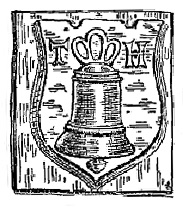
The Hatch bell foundry at Ulcombe, near Maidstone, in Kent, England, was operated by three generations of the Hatch family from 1581 or earlier until 1664. The bellfounders were based at nearby Broomfield from about 1587 until at least 1639. Joseph Hatch, bellfounder from 1602 to 1639, cast at least 155 bells, including "Bell Harry", after which the central tower of Canterbury Cathedral is named. Most Hatch bells were used in churches east of the River Medway in East Kent.



















